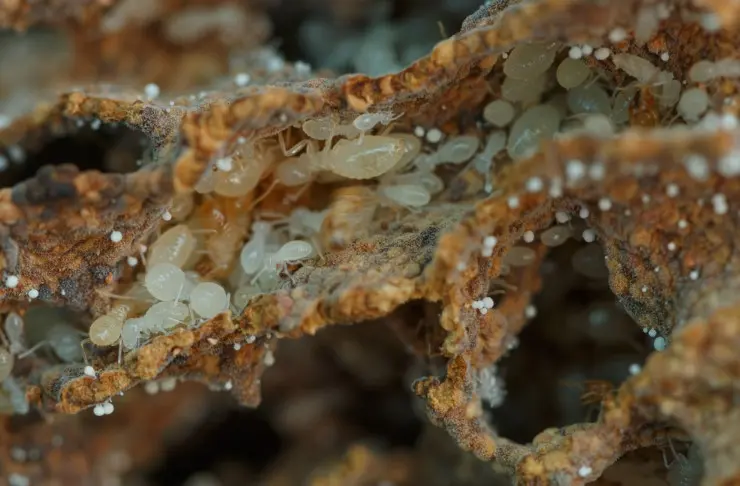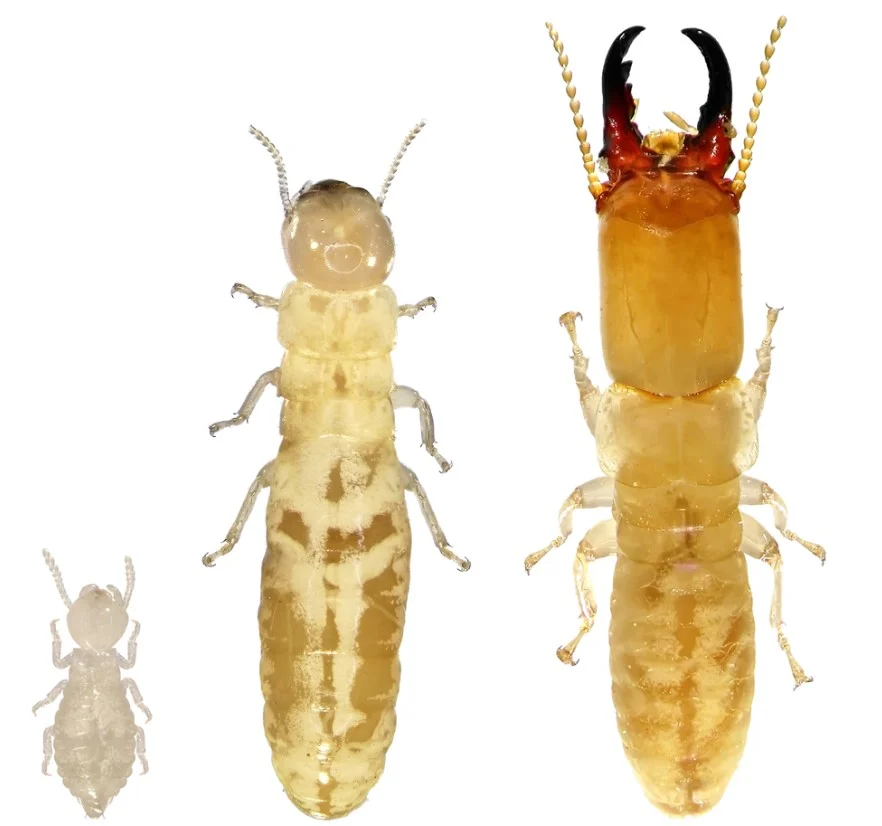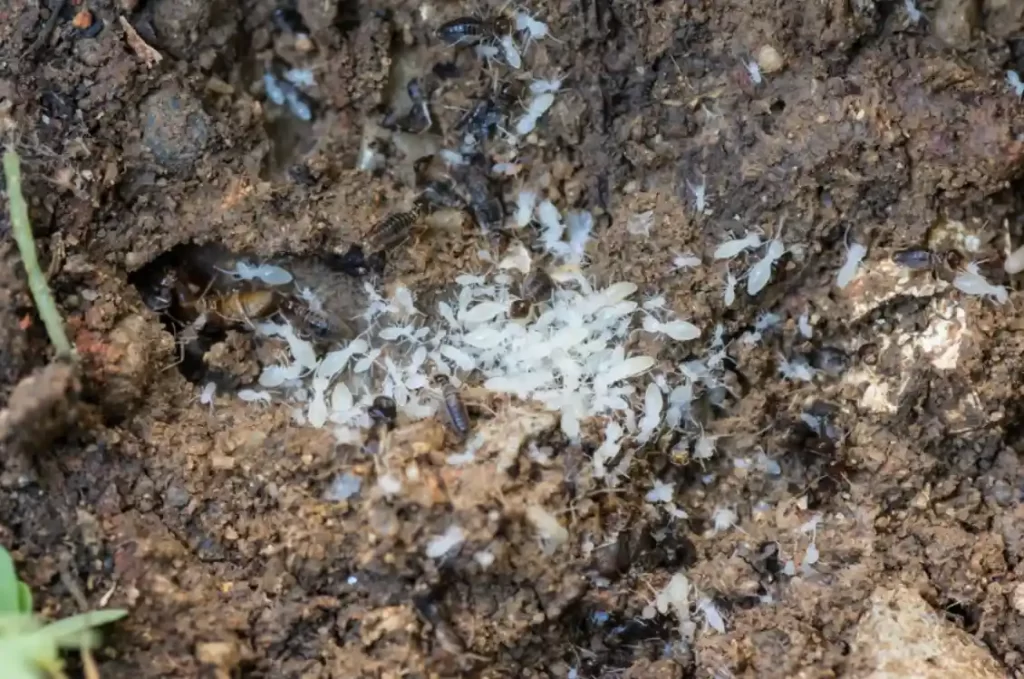While no one wants any kind of bug in their home, termite babies are especially loathed. If you see small size, wingless and ant-like insects in or around your home, do not take them lite because they can cause unrepairable damage to your home.
Your home, garage, or storage facility might suffer tens of thousands of dollars in damage if they were to invade. Nearly a billion dollars’ worth of property damage is attributed to termites every year in the United States.
These pests like a quiet meal of your home’s wooden structure, and the resulting damage will do the talking for them. The even more alarming truth is that if they are not stopped, they will rapidly multiply and decimate their environment.
Read on to find out all you need to know about young termites if you’ve made the decision to detect them and eradicate the infestation from its foundations.
Page Contents
Termite life cycle
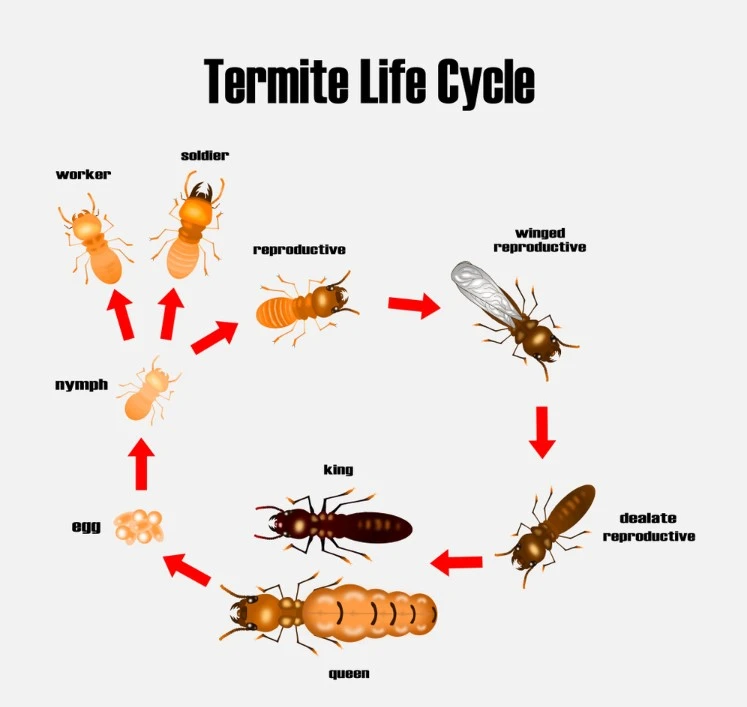
What are baby termites?
Baby termites are apparently white or translucent, young, and immature. This stage of termites’ life cycle is called nymphs; that’s why baby termites are also called nymphs. Nymphs are small in size, and this stage comes just before adulthood.
Queen termite, responsible for all the matters of the colony, including reproduction and maintenance, lays eggs and hatch them. Baby termites or nymphs are born after egg hatching and then pass through several stages of development to reach the stage of adulthood.
During the period me maturing, termites shed their exoskeletons several times and change their color.
Baby termites play essential roles in the safety and development of the colony. From protecting the territory from predators to collecting food for all the termites in the colony, they work hard.
Moreover, they also contribute to the growth of the termites’ population. In case of food shortage, they are a healthy source of food for adult termites because they are enriched with nutrients.
Types of baby termites
During the development period, baby termites are assigned different roles within the colony. The colony is categorized by the type of work they are assigned. Let’s discuss each type and type of work they are assigned:
Labourer Termites
These baby termites are present in large numbers and assigned several tasks within the colony. They are responsible for searching for new food resources and collecting food in the colony.
They are also responsible for finding new places to build nests, maintaining them, and caring for the young termites.
You can identify them by their white or translucent color and tiny size.
Soldiers Termites
This type of termite is responsible for protecting the colony from outsiders and predators. They are stronger and larger in size than worker termites.
Their unique body appearance with larger mandibles or special glandular secretions set them apart from other termites of the colony and point them as a defender of the colony.
Reproductive Termites
This type of termite is more mature and developed than other types. Their size is also larger, and they are assigned to reproduce and increase the growth of termites in different colonies.
They have wings and can fly from one colony to another and grow more than one colony at a time.
Further, there are two types of reproductive termites: primary termites, assigned to lay more eggs, and secondary termites, fertilize these eggs and hatch them until they are born.
Alate Termites
This type of termite has grown up and has wings to fly from the parent colony to other colonies. They are also known as a swarmer and assist reproductive termites in starting and maintaining new colonies.
Their size is also larger than common termites because they have developed after passing a few stages of termites’ life cycle.
Queen Termites
Queen termite is the main member of the termites’ colony, which reproduce and maintain all the matters of the colony. She is the most developed and mature type and typically larger in size than other types of termites.
She can lay hundreds or thousands of eggs daily, increasing the population exponentially.
The queen termites are located in the center of the colony and surrounded by other types of termites.
Worker and soldier termites protect and care for queen termites.
The role of each type is crucial, and they play it responsibly, which is why they are very destructive to your home.
How small are baby termites?
Generally, the size of baby termites depends upon the stage they are living in and the role they are playing in the colony.
Before reaching adulthood, termites pass through different stages, and their size differs at each stage.
Let’s talk about their body size according to their role or type in the colony:
Laborer termites that collect food for the colony members are the smallest in size and are less developed than each other type.
Soldier termites are healthier and stronger than workers. They are larger in size and have developed larger mandibles to protect the colony from predators.
Reproductive nymphs, which assist in reproduction and maintain new colonies, are more developed and have wings. They can fly from the parent colony to new colonies and retain them in a better way.
Alate termites also have wings and help reproductive termites in settling new colonies. Their size is larger than the soldiers and workers.
Queen termites lay eggs for reproduction in the colony and are larger in size than other types of termites.
What do baby termites look like?
Baby termites continuously undergo several stages of development called metamorphosis until they reach the adult termites’ stage.
During these stages of development, they shed their exoskeletons several times and keep changing their appearance at each stage.
Generally, the body appearance of baby termites is pale or white, their size is small, and they are wingless. As they go through metamorphosis, they grow large in size and become mature.
Before reaching adulthood, they are responsible for playing a specific role in the colony’s development.
When fully developed and become adult termites, they turn brown or black and have a segmented body.
They also have wings, thorax, abdomen, stronger mandibles, and antennae on their body.
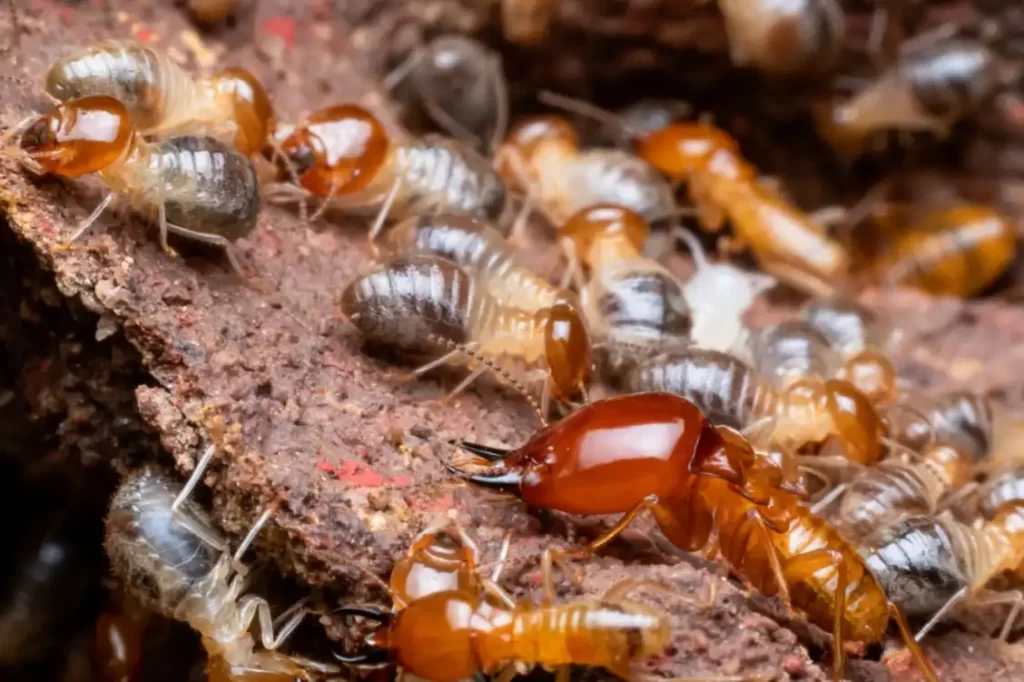
What do baby termites eat?
Baby termites are not developed and mature, so they don’t have wings to fly in search of food. Instead, they depend on other termites to care for and feed them.
Termites follow a very strict hierarchy of roles within the colony. It is the duty and responsibility of mature and developed termites to search for food and collect in the colony for baby termites.
Their primary source of food is wood and plant materials. They utilize a special bacterium from their guts to break down the cellulose present in the wood.
In urban areas, they eat the wood structure of buildings and furniture and severely damage them. The food-collecting termites collect these small pieces of wood and bring them back to the colony for baby termites and queens.
Baby termites chew these pieces and then puke this half-processed wood. Then other members of the colony eat this partially digested food. This process of food distribution is called trophallaxis.
Where do baby termites live?
Termite larvae form colonies and operate according to a strict hierarchy. These communities are housed in subterranean and wooden buildings.
Termites have adapted to a wide variety of environments as a result of environmental disruptions. They populate woodlands, prairies, and even deserts.
Termite offspring are fully dependent on their caregivers—the adults—for everything. Termite nests are located within the colony, and the termite population lives there.
Like mature termites, they are given specialized roles to perform in the colony’s progress as they expand in size and strength.
Do baby termites fly?
Baby termites are usually rather tiny. Because they are young and underdeveloped, they lack the ability to fly and hunt for food.
They live in colonies with adult termites and are cared for and fed by them. Until they mature and become huge, baby termites spend the most of their time in nests.
Alate is the only termite with wings that can fly from colony to colony. Baby termites go through multiple phases of development before reaching this stage.
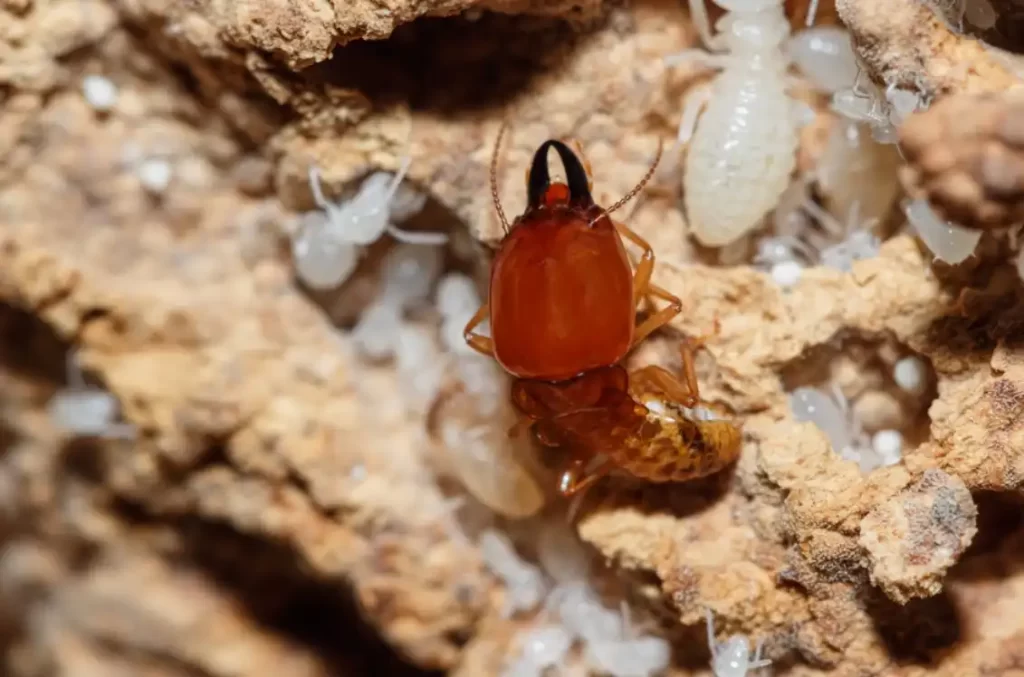
Baby termites vs ants
Baby termites and ants are quite similar to some extent because they belong to the same group named Hymenoptera, but their families are entirely different.
Although they both are insects and live within large colonies following a strict hierarchy, one major difference is the eating habit of termites, they eat wood, and ants do not.
However, in both families, queens lay eggs and hatch them. Then babies are born as larvae who pass through different development phases to reach adulthood.
Adults of both families feed babies and protect them from external threats until they mature fully.
But another major difference between both families is that in termites colonies, only one queen lives in each colony, while in the case of ants, multiple ant queens can stay in one colony.
Both are similar in many ways and play their essential roles in their colonies according to their family natures.
Baby termites vs adult termites
Baby termites are nymphs at an immature growth stage. When adult termites lay eggs and hatch them, then nymphs are born and cared for by adult termites till they are fully grown and can survive on their own.
Between baby termites and adult termites, there are several phases that babies have to pass through to reach adulthood.
After egg hatching, the first stage is nymphs or baby termites which are small in size and cannot fly.
Next stage, termites are called soldiers because they are young and stronger. They have developed specific parts of their body that they used to protect the colony.
The next stage termites are known as reproductive termites, and they can fly because they have developed wings and grown large in size.
The last stage is the adult stage. They are fully developed and mature termites that can reproduce and lay eggs to grow their population.
Baby termites compared to maggots
Maggots are also immature insects of the flies family, like baby termites from the termites family. They have few traits in common, but there are also many key differences between them. Let’s discuss them one by one.
The primary difference is the parent family of both insects. Maggots are the larvae of the flies’ family and belong to the order Diptera while baby termite is the immature stage of termites and belongs to the order Isoptera.
The second major difference between both insects is their body appearance and behavior. Baby termites are pale in color, small in size, and wingless, but they resemble adult termites in shape.
On the contrary, maggots are legless larvae and look like worms of white or pale color. They are present in peaks of garbage or place of decomposition, and they feed on decaying animals and rotten foods.
What to do with baby termites?
Baby termites are no less than a nightmare for homeowners. Their presence in your home can cause costly damage to you. If you suspect the presence of baby termites in your home, take the following necessary steps to present further destruction:
Search for the point of infestation
If you find any termites in or around your surroundings, it means that there is an entire infestation in your home. Search for the sign of their infestation, like, mud tubes or destructive wood, to trace their exact location.
Destroy their infestation
When you successfully pin the location of the infestation, instantly take steps and destroy it. It may need to cut that wood area, seal specific cracks or gaps or remove the infested area with chemicals.
Hire professionals from a pest control company
After a continuous search, if you fail to find the location of the infestation, call any pest control company for help. The pest control professionals have training and knowledge of tools that they can effectively use to eradicate the infestation of termites.
Follow Preventive measurements
After the visit of pest control professionals, there are still chances for infestation in the future. If you want to avoid their infestation in the future, follow preventive steps such as removing any moisture content or wood source, filling gaps and cracks in foundations, and adopting a daily cleaning habit in your property.
If you carefully follow these tips, you can easily deal with the presence of baby termites and protect your home from their future attack.
Final Verdict
Baby termites or nymphs are small in size and immature in termites’ life. Despite their small size, they play an essential role in their colony and prove their worth in development. They are wingless and cannot fly in search of food, and that’s why they rely on the care and nourishment of adult termites. They live under a strict social hierarchy and divide their work among each type of termite according to their body size and strength.
If you see baby termites in or around your property, trace their marks to find the main infestation. Once you locate their infestation, please take the necessary actions to remove it. Moreover, follow preventive steps to avoid their future infestation in your home.
- Where Can I Purchase Bed Bug Bombs? - January 30, 2023
- Where Can I Buy Something to Kill Bed Bugs? - January 30, 2023
- Where Can I Buy Bed Bug Spray? - January 30, 2023

